Yafang Mao, Co-op Director, Joint Co-op Institute, Chongqing University-University of Cincinnati
Stephen Ettorre, Associate Professor, Department of Electrical Engineering and Computer Science, University of Cincinnati
Fu-Lin Tsung, Associate Professor, Department of Mechanical and Materials Engineering, University of Cincinnati
Abstract
The cooperative engineering education model (co-op) is comprised of both classroom instruction and direct industry/research experience. The approach is well established and proven effective in many parts of the world. However, it has only recently been implemented in China. As a result, early investigation and an understanding regarding its adoption within the framework of the Chinese higher education system is critical to improve the model’s effectiveness and success in China. In this paper, collected data including both positive and negative factors that encourage and inhibit employers’ participation in the co-op program in China are examined. The span of companies surveyed include state owned, private, joint-ventures and research organizations. The significant factors that motivate employer participation are largely internal to the organizations. These include the desire to create and build close relationships with universities, corporate responsibility to higher education, company brand promotion inside the university, and direct access to new/innovative ideas. Key factors that inhibit participation are disruptions due to external market fluctuations and employer concerns with students’ abilities to contribute to the organization’s mission. The result and analysis in this paper provide insights into employers’ perspective of the co-op program and also guidance to develop, promote, and grow a successful and effective co-op program in China.
Key words: Co-op program, educational institutions, employers, students, factors, engineering, cooperative
Introduction
The co-op model for engineering education was founded by University of Cincinnati (UC), Cincinnati, Ohio (OH), USA in 1906. Students alternate semesters involving traditional classroom instruction and semesters spent working full-time with organizations that specialize in their field of study. The added element of real-world, engineering experience in a professional setting has been found to enrich the overall education experience and better prepare students for their professional careers. The benefit of this educational model is evident from its widespread adoption around the world. The World Association for Cooperative Education [WACE, 2019] reports it works with 913 Institutions in 52 countries. Previous studies have examined the benefits of the co-op model implementation outside of China. The findings are summarized in the following.
- Universities benefited from expanded relationships with industry with increased collaborative work opportunities, guidance for curriculum development to ensure relevance and modernization, and improved student recruitment [Weisz & Chapman, 2004].
- Students benefited not only by having additional financial resources (pay) to support their educational costs, the experience advanced their professional development. Industry network opportunities gives them a competitive edge in the job market [Strubel, et al. (2015)]; exposure gives them broader career options and higher starting salary [Singel (1983)]; and their work experience provides positive feed-back and increased motivation to excel in the classroom. [Green (1996)].
- Employers also benefited greatly from the program. Co-op provided a pipeline of new engineering hires and utilized the program to smooth fluctuations in full-time hiring [Barry (2016)]. Employers reduced recruitment cost, reduced training cost, and found co-op trained students are better communicators [Braunstein and Loken (2004)]. Co-op Programs created links with the universities to bring fresh ideas and innovative problem-solving methods [Mclaren (1999)]. Finally, students act as an important conduit between local firms and university faculty which keeps the companies abreast of major pending technical advances, Bramwell and Wolfe (2008).
With the goal to improve the engineering education model in China, Chongqing University has brought in the first and currently, the only co-op program for engineering education in China by partnering with University of Cincinnati. The program was initiated in 2013, and the Chongqing University-University of Cincinnati Joint Co-op Institute (JCI) was established to promote the first co-op program with Mechanical and Electrical Engineering students. In this program, JCI students enroll in the same classes and have the same co-op rotations as American students in Cincinnati, OH. Over the past six years, JCI has established a co-op network with more than 50 employers in China. The remainder of the paper examines survey data to gain insight into the employers’ views on the co-op model in China. Analyses are presented in the ensuing sections, including factors which specifically promote and factors that impede employer participation. In addition, secondary factors including direct government support and access to university for research collaboration are also examined, and key conclusions are summarized at the end.
Analysis of Survey Results
Positive Factors that Promote Employer Participation in Co-op Program
This study is aimed at analyzing what drives employers to participate in the co-op program and what we can do as educational institutions to promote its development. Firstly, initial interviews were conducted with 15 employers (6 joint ventures, 4 state-owned companies, 3 private companies and 2 research institutes). According to the interview, seven reasons which drive employers’ participation in a co-op program and four reasons which might prevent employers from participating in a co-op program were summarized and designed in the questionnaire for deeper investigation. The Likert Scale was used to analyze the importance of each reason (1 means the least important, 5 means the most important). In this study, 35 co-op employers were interviewed through questionnaires and interviews. More than 80% of these employers have cooperated with JCI for more than 3 years. As a result, they have a high degree of familiarity with the program. Figure 1 presents a breakdown of the companies in the study. The most prevalent are joint ventures. These organizations either have parent companies that are familiar with the co-op program or at least have partnership arrangements with universities in other countries. Among all the employers cooperating with JCI, joint ventures account for the majority. This shows that an understanding of the concept of co-op or related exposure to a co-op program can help employers more easily accept it in a different environment. Co-op program is a brand new concept for many Chinese companies as Chongqing University is the first one to introduce it. Companies need time to understand and experiment with the concept of co-operative education.

Figure 1: Employer Types
The next characterization is the job position of the employer representatives who were interviewed. The breakdown is shown in Figure 2. In this study, the highest percentage of respondents (45.7%) are Human Resource (HR) professionals. This is not surprising since in general, HR organizations are the main departments to interface with universities. Additionally, nearly 40% of the remaining respondents are engineers or technicians who are mentoring or have mentored JCI co-op students in the past. Managers account for the final remaining 14% of the respondent positions.

Figure 2: Respondent Job Positions
The interview questionnaire is structured to identify the key factors which motivate and inhibit company participation in the JCI co-op program. Motivational factors are comprised of the following 7 reasons/drivers.
- Selecting potential employees in a real engineering environment
- Corporate responsibility to contribute to education
- Create close relationships with educational institutions
- Brand promotion inside the university
- Access to fresh ideas brought in by students
- Cheaper recruitment
- Staffing to satisfy demand for short-term projects
The raw responses for each factor are shown as run plots in Figures 3-10. The Likert Scale is applied to weight the importance of a given factor in the company responses (1 – least important, 5 – most important). Note, company abbreviations used for these figures are summarized in the Appendix. What is immediately apparent from the figures is that the most significant factors driving company participation in the JCI co-op program are: 3) Create close relationships with educational institutions, 4) Brand promotion inside the university and 5) Access to fresh ideas brought in by students. Factor 2) Corporate responsibility for contributing to education also scores high. It is interesting that factors 2, 3 and 4 represent internal organizational motivations for the companies to draw closer to the university. Factor 5 is best categorized as something that the companies receive as a result of the co-op relationship. Based on this, one can conclude that companies in China place high value on relationships with universities. It may be that the JCI co-op program represents a new and significant mechanism for companies to express the importance of this relationship. This result also seems to indicate that there is a desire to strengthen the relationship by both the companies and the university. This is encouraging in that it points to the potential for expanded relationships going forward.

Figure 3: Positive Factor 1 Responses

Figure 4: Positive Factor 2 Responses
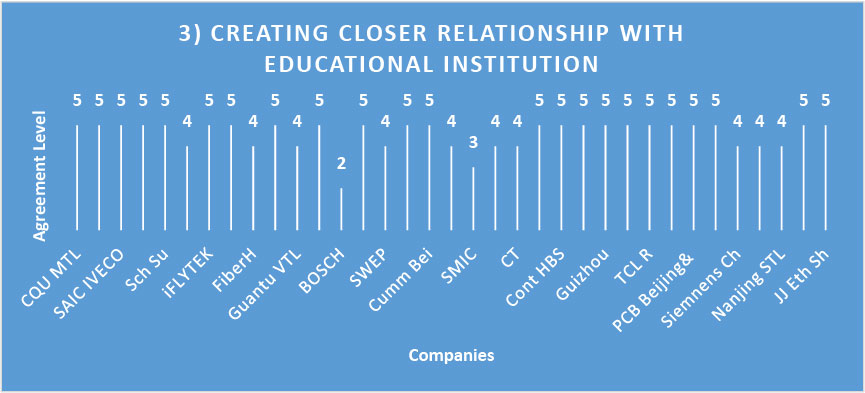
Figure 5: Positive Factor 3 Responses
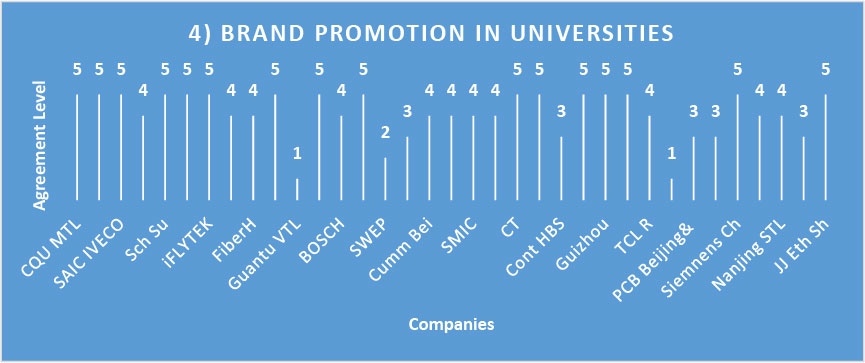
Figure 6: Positive Factor 4 Responses

Figure 7: Positive Factor 5 Responses
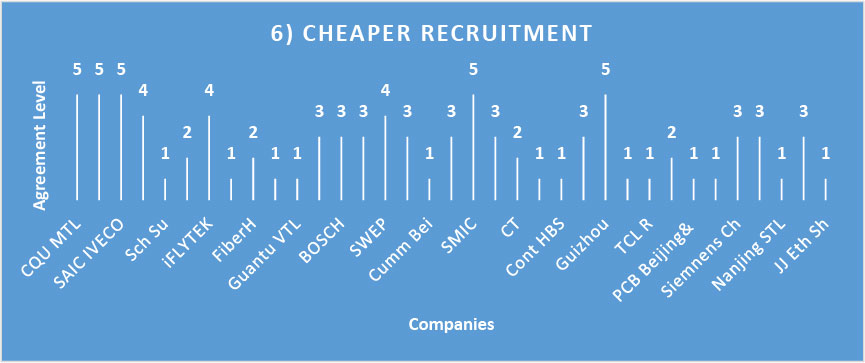
Figure 8: Positive Factor 6 Responses
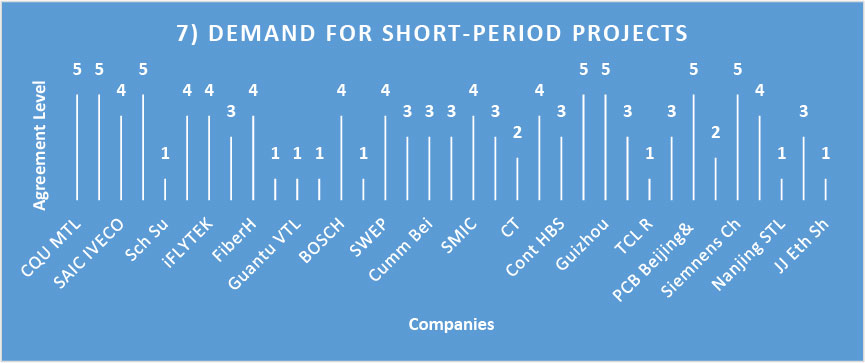
Figure 9: Positive Factor 7 Responses
Sample statistics for the respondent data are listed in Table 1. A spider chart for the sample mean values is shown in Figure 10. On average the strongest motivation for company participation for all types of organizations is 3) Create close relationships with educational institutions. Other significant factors are:
2) Corporate responsibility to contribute to education
4) Brand promotion inside the university
5) Access to fresh ideas brought in by students
These results are consistent with the trends shown in the run charts. The strongest factors tend to be internal to the organizations. For these factors 2, 3 and 4 the standard deviation values are relatively low which indicates uniform strength across all organization types. Responses for factor 5 show more significant variation across company types. Similar to the results from the run charts, factor 6) cheaper recruitment is the weakest motivational consideration for all organization types.

Table 1: Sample Statistics for Positive Factor Respondent Data

Figure 10: Spider Chart – Mean Values – Positive Responses
Negative Factors that Inhibit Employer Participation in Co-op Program
In addition to the seven reasons which positively drive employers’ participation in the co-op initiative, four reasons which may prevent employers from participating in a co-op program were also summarized through the interview. These negative factors are: 1) market fluctuations, 2) already have existing internship program targeting upperclassman, 3) students’ abilities cannot meet employers’ needs and 4) high cost to the employer. Again, the Likert scale is used to score participants’ responses (1-least important, 5-most important). Run charts for the negative factor responses are shown in Figures 11 – 14. Review of the data in these figures indicates that the most significant negative factors are 1) external market fluctuations and 3) employer concerns with student abilities to contribute to the mission of the organization. The significance of factor 1 is not surprising as this would seem to be broadly applicable for any type of industry initiative. The second factor may be a result of the relative newness of the co-op program within China and highlights the responsibility of the university to equip students to be successful in their co-op assignments.
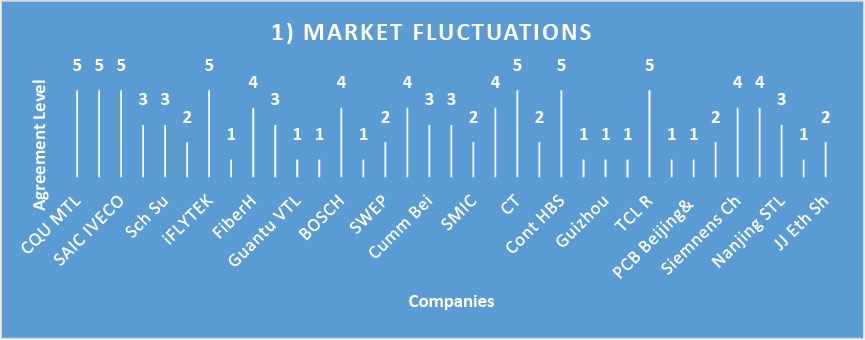
Figure 11 – Negative Factor 1 Responses

Figure 12 – Negative Factor 2 Responses

Figure 13 – Negative Factor 3 Responses

Figure 14 – Negative Factor 4 Responses
Sample statistics for the negative factor respondent data are listed in Table 2. A spider chart for the sample mean values is shown in Figure 15.

Table 2 – Sample Statistics for Negative Factor Respondent Data

Figure 15 – Spider Chart – Mean Values – Negative Responses
The mean value data reported in Table 2 support the conclusions drawn from the run charts: factors (1) and (3) are the most significant. Additional observations are:
- For factor 1) Market Fluctuations – the lowest mean response is for State Owned Companies. This is not surprising since these types of organizations are largely insulated from market forces.
- For factor 3) Students’ Abilities to Meet Employers’ Needs – the standard deviation is the lowest for all factors. In turn, this indicates that this is a significant factor for all organization types. This result is also evident in the spider chart shown in Figure 15.
Additional Factors that Affect Employers’ Participation in Co-op Program
The final survey category probes the factors that affect employer decisions to participate in the co-op program. Two specific factors are built into the survey:
- Availability of direct government support – This could take the forms of tax deductions, intern subsidies, etc.
- Access to university faculty for collaboration on research projects
Run charts for the company responses are shown in Figures 16 and 17. From the figures, it is apparent that both factors have influence on company decisions to participate in the program. In particular, opportunities to collaborate with university faculty on pertinent research projects is a significant draw for company participation. Universities can exploit this to leverage the co-op program to expand their relationships with companies and potentially accrue more research funding. This sets up a win-win relationship. Specific initiatives could include the following:
- Educational institutions can promote company/university cooperation by encouraging faculty to participate in the research programs founded by companies, inviting companies on campus to sponsor information sessions and/or hold open-house sessions at company locations for students and faculty.
- Establish co-op advisory boards including engineering experts from different industries to offer guidance on how to improve engineering curricula and align engineering student training with industry needs.
- Government has a role to encourage the co-op model both by policy and fiscally. The latter could take the form of tax deductions and company subsidies for their participation in this new model of higher, engineering education.

Figure 16 – Factor 1 Inhibiting Company Participation in Co-op Program

Figure 17- Factor 2 Affecting Company Participation in Co-op Program
Conclusion
This paper examines survey data to isolate key factors that both motivate and inhibit employer participation in the co-op model in China for engineering education at the university level. The co-op education model in China is still in its nascent stage. As a result, employer attitudes towards the model are still in the formative stage. Key results include:
- Significant factors which encourage employer participation are largely internal to the organizations. These include a desire to create and build close relationships with universities, corporate responsibility to contribute to higher education, company brand promotion inside the university and direct access to new/innovative ideas brought in by students who are receiving the most modern training.
- Factors that inhibit participation are disruptions due to external market fluctuations and employer concerns with students’ abilities to contribute to the mission of the organization. The first factor is not surprising as it reflects the nature of business in general. The latter factor is likely due to the relative newness of the co-op program in China.
The results in this paper provide better insight into the employers’ view of the co-op program and provide guidance for the development of further measures to promote and grow the co-op program in China. Specifically, educational institutions can promote company/university cooperation by encouraging faculty to participate in the research programs founded by companies, inviting companies on campus to sponsor information sessions and/or hold open-house sessions at company locations for students and faculty. In addition, co-op advisory boards including engineering experts from different industries could be established to offer feasible suggestions on how to improve engineering curricula and better align student training with industry needs. As a final item, government can encourage the co-op model both by policy and fiscally. The latter could take the form of tax deductions and company subsidies for their participation in this new model of higher, engineering education.
References
Barry, E. B., Ohland, W. M., Mumford, J. K., and Long, A. R., “Influence of job market conditions on engineering cooperative education participation”, Journal of Professional Issues in Engineering Education and Practice Vol. 142, No. 3, 2016, pp. 8.
https://ascelibrary.org/doi/abs/10.1061/(ASCE)EI.1943-5541.0000270
Bramwell, A., and Wolfe, A. D., “Universities and regional economic development: The entrepreneurial University of Waterloo”, Journal of Research Policy Vol. 37, 2008, pp. 1175-1187.
https://www.sciencedirect.com/science/article/abs/pii/S0048733308000917
Braunstein, L. A., and Loken, M. K., “Benefits of cooperative education for employers”, International Handbook for Cooperative Education, 2004, pp. 237-245.
https://www.voced.edu.au/content/ngv%3A36785
Green, L., “Schools and industry: working together”, IEEE Technical Applications Conference, 1996, pp. 19-20.
https://ieeexplore.ieee.org/abstract/document/564725
McLaren, L., “Critical elements of a co-op program”, IEEE Conference Record of Annual Pulp and Paper Industry Technical Conference, 1999, pp. 145-156.
https://ieeexplore.ieee.org/abstract/document/779359
Singel, T., “Co-oping: a short-term option with long-term payoffs”, IEEE Potentials Vol. 2, 1983, pp. 32-33.
https://ieeexplore.ieee.org/abstract/document/6499611
Strubel, B., Main, J., Ramirez, N., Davis, J., and Ohland, M., “Modeling student perceived costs and benefits to cooperative education programs (Co-ops) and pathways to participation,” 2015 IEEE Frontiers in Education Conference (FIE), 2015, pp. 1-6.
https://ieeexplore.ieee.org/abstract/document/7344400/references#references
WACE 2019 Global Institutions Listing.
Weisz, M., and Chapman, R., “Benefits of cooperative education for educational institutions”, International Handbook for Cooperative Education, 2004, pp. 247-258.
https://www.voced.edu.au/content/ngv%3A36785
 About Yafang Mao
About Yafang Mao
Yafang has been actively promoting the co-op education in China since JCI’s inception. Launched in 2013, JCI at Chongqing University became the first major university in China with a co-op program. The institute has now collaborated with more than 60 companies, and the program was awarded by the China Ministry of Education in 2020 as a first-tier practical education class.
 About Stephen M Ettorre
About Stephen M Ettorre
Joined UC-Joint Co-op Institute (JCI) after 40 year technical/management career in nuclear and aviation industries. JCI is an inaugural program between UC and Chongqing University (CQU), China featuring co-operative based education for Chinese engineering students. Responsible for instruction in electrical engineering at both schools and mentoring Chinese students in career and professional development from perspective of American education and industry.
 About Fu-Lin Tsung
About Fu-Lin Tsung
Joined UC after 25 years of research and industrial experience from Georgia Tech School of Aerospace Engineering, Institute for Computational Mechanics in Propulsion at the NASA Glenn Research Center, and GE Aviation. Areas of specialization include computational fluid dynamics, fixed and rotary wing aerodynamics, turbomachinery flow, and engineering education. Currently splitting time teaching on campuses of both UC and Chongqing University.